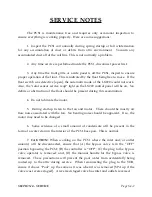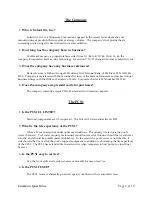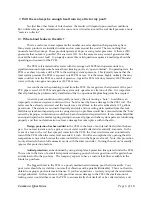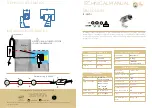
Common Questions
Page 3 of 10
5.
What kind of electrical power is required?
220 vac is required. Full load amperage is 1.8 amps. A separate, 15 amp circuit, with a double
pole safety cutoff switch and outlet by the PCS1 is recommended. The PCS1 must be wired in accordance
with local, state, & national electrical codes.
6.
Is there any condensation in the attic at high humidity levels?
Under extreme test conditions, very little condensate was evidenced. Under normal conditions,
the bottom pan may collect minor amounts and it then will evaporate. This same technique is used on
modern frost free refrigerators. The PCS1 provides for this collection and evaporation when mounted
upright. In areas where concern exists, the bottom pan can be tapped and drained off. Any condensate
can also be collected as distilled water if bottled.
7.
What is the optimum heating system configuration?
PCS1 which exchanges free solar heat inexpensively from the attic into the swimming pool, a
flowreversalª valve that ensures the pool is efficient in its heat needs and a pool blanket to minimize
losses during extended periods of non use.
8.
The PCS1 looks like a radiator?
The principles of operation are similar but the radiator was designed for cars. The PCS1 coil
was custom designed specifically for the needs of pools.
Technical Issues
1.
How does SolarAttic measure the BTU ratings? Sensible only or with latent?
All quoted BTU ratings are sensible heat figures only. Delta temperatures can be measured
with temperature sensors & sensible heat calculated. BTU figures are significantly higher if latent
heat figures were included. BTU figures are higher under high humidity conditions as humid air
contains more heat. BTU figures were calculated and measured under conditions of 20-30 % RH.
2.
How hot do attics get?
Attics have been measured at 160 degrees Fahrenheit.
3.
How do I get the PCS1 into the attic?
A) In a walk-in attic, no problem, just carry it up. B) In an attic with a 2x2 foot access, enlarge
the access to 2x4 feet. C) Cut into the end of the house at the peak to access the attic, then cover hole
with a vent grille [found at lumber yards & building stores]. D) Cut a new access hole into attic from the
inside; the unit fits between standard 24" OC [on center] trusses. E) Disassemble the unit and reassemble
it in the attic [not recommended; but, can be done]. F) Cut a new access hole in the roof and mount the
PCS1 on the roof with a rain cover & condensate drain provision.
Note: the PCS1 mounts in any direction, but any direction other than horizontal requires a
condensate drain provision. Use your imagination and create a list of 10 different ways for each new
installation. Then select the best way, keeping the plumbing considerations in mind. This is called
possibility thinking!
Summary of Contents for PCS1
Page 7: ...SECTION 1 SYSTEM ARRIVAL Page S1 1 SECTION ONE SYSTEM ARRIVAL...
Page 22: ...SECTION 2 HEATING DATA Page S2 1 SECTION TWO HEATING DATA...
Page 28: ...BTUS Vs GPM BTUS Vs T SECTION 2 HEATING DATA Page S2 7...
Page 34: ...SECTION 3 INSTALLATION Page S3 1 SECTION THREE INSTALLATION...
Page 65: ...Attic Installation Photos SECTION 3 INSTALLATION Page S3 31...
Page 66: ...Attic Installation Photos SECTION 3 INSTALLATION Page S3 32...
Page 88: ...SECTION 4 SERVICE Page S4 1 SECTION FOUR SERVICE...
Page 99: ...Common Questions Page 1 of 10 COMMON QUESTIONS...
Page 109: ...Dictionary of Terms Page 1 of 4 DICTIONARY OF TERMS...
















































